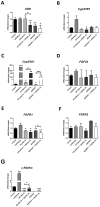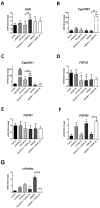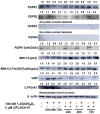Fibroblast Growth Factor Receptor Inhibitors Decrease Proliferation of Melanoma Cell Lines and Their Activity Is Modulated by Vitamin D
- PMID: 38473753
- PMCID: PMC10931346
- DOI: 10.3390/ijms25052505
Fibroblast Growth Factor Receptor Inhibitors Decrease Proliferation of Melanoma Cell Lines and Their Activity Is Modulated by Vitamin D
Abstract
Regardless of the unprecedented progress in malignant melanoma treatment strategies and clinical outcomes of patients during the last twelve years, this skin cancer remains the most lethal one. We have previously documented that vitamin D and its low-calcaemic analogues enhance the anticancer activity of drugs including a classic chemotherapeutic-dacarbazine-and an antiangiogenic VEGFRs inhibitor-cediranib. In this study, we explored the response of A375 and RPMI7951 melanoma lines to CPL304110 (CPL110), a novel selective inhibitor of fibroblast growth factor receptors (FGFRs), and compared its efficacy with that of AZD4547, the first-generation FGFRs selective inhibitor. We also tested whether 1,25(OH)2D3, the active form of vitamin D, modulates the response of the cells to these drugs. CPL304110 efficiently decreased the viability of melanoma cells in both A375 and RPMI7951 cell lines, with the IC50 value below 1 µM. However, the metastatic RPMI7951 melanoma cells were less sensitive to the tested drug than A375 cells, isolated from primary tumour site. Both tested FGFR inhibitors triggered G0/G1 cell cycle arrest in A375 melanoma cells and increased apoptotic/necrotic SubG1 fraction in RPMI7951 melanoma cells. 1,25(OH)2D3 modulated the efficacy of CPL304110, by decreasing the IC50 value by more than 4-fold in A375 cell line, but not in RPMI7951 cells. Further analysis revealed that both inhibitors impact vitamin D signalling to some extent, and this effect is cell line-specific. On the other hand, 1,25(OH)2D3, have an impact on the expression of FGFR receptors and phosphorylation (FGFR-Tyr653/654). Interestingly, 1,25(OH)2D3 and CPL304110 co-treatment resulted in activation of the ERK1/2 pathway in A375 cells. Our results strongly suggested possible crosstalk between vitamin D-activated pathways and activity of FGFR inhibitors, which should be considered in further clinical studies.
Keywords: 1,25(OH)2D; AZD4547; CPL304110; FGFR; FGFR inhibitors; melanoma; vitamin D.
Conflict of interest statement
Authors D.P. and M.W. was employed by the company Celon Pharma S.A. The remaining authors declare that the research was conducted in the absence of any commercial or financial relationships that could be construed as a potential conflict of interest.
Figures







Similar articles
-
Vitamin D and its low calcemic analogs modulate the anticancer properties of cisplatin and dacarbazine in the human melanoma A375 cell line.Int J Oncol. 2019 Apr;54(4):1481-1495. doi: 10.3892/ijo.2019.4725. Epub 2019 Feb 25. Int J Oncol. 2019. PMID: 30968156 Free PMC article.
-
Antiproliferative activity of side-chain truncated vitamin D analogs (PRI-1203 and PRI-1204) against human malignant melanoma cell lines.Eur J Pharmacol. 2020 Aug 15;881:173170. doi: 10.1016/j.ejphar.2020.173170. Epub 2020 May 20. Eur J Pharmacol. 2020. PMID: 32445704
-
Anticancer Activity of Vitamin D, Lumisterol and Selected Derivatives against Human Malignant Melanoma Cell Lines.Int J Mol Sci. 2024 Oct 10;25(20):10914. doi: 10.3390/ijms252010914. Int J Mol Sci. 2024. PMID: 39456696 Free PMC article.
-
Vitamin D and systemic cancer: is this relevant to malignant melanoma?Br J Dermatol. 2002 Aug;147(2):197-213. doi: 10.1046/j.1365-2133.2002.04960.x. Br J Dermatol. 2002. PMID: 12174089 Review.
-
Vitamin D in thyroid tumorigenesis and development.Prog Histochem Cytochem. 2013 Aug;48(2):65-98. doi: 10.1016/j.proghi.2013.07.001. Epub 2013 Jul 26. Prog Histochem Cytochem. 2013. PMID: 23890557 Review.
Cited by
-
Vitamin D Reshapes Genomic Hierarchies in Skin Cells: lncRNA-Driven Responses in Carcinoma Versus Transcription Factor-Based Regulation in Healthy Skin.Int J Mol Sci. 2025 Jul 10;26(14):6632. doi: 10.3390/ijms26146632. Int J Mol Sci. 2025. PMID: 40724881 Free PMC article.
-
Tumor Microenvironment in Melanoma-Characteristic and Clinical Implications.Int J Mol Sci. 2025 Jul 15;26(14):6778. doi: 10.3390/ijms26146778. Int J Mol Sci. 2025. PMID: 40725022 Free PMC article. Review.
-
Therapeutic potential of calcitriol in cerebral ischemia/reperfusion injury: In vivo and in silico insights into TLR4 and FGFR2 pathways.IBRO Neurosci Rep. 2025 Jul 29;19:345-353. doi: 10.1016/j.ibneur.2025.06.018. eCollection 2025 Dec. IBRO Neurosci Rep. 2025. PMID: 40791737 Free PMC article.
References
-
- Garbe C., Amaral T., Peris K., Hauschild A., Arenberger P., Basset-Seguin N., Bastholt L., Bataille V., Del Marmol V., Dréno B., et al. European consensus-based interdisciplinary guideline for melanoma. Part 1: Diagnostics: Update 2022. Eur. J. Cancer. 2022;170:236–255. doi: 10.1016/j.ejca.2022.03.008. - DOI - PubMed
-
- Ascierto P.A., Puzanov I., Agarwala S.S., Blank C., Carvajal R.D., Demaria S., Dummer R., Ernstoff M., Ferrone S., Fox B.A., et al. Perspectives in melanoma: Meeting report from the “Melanoma Bridge” (December 5th–7th, 2019, Naples, Italy) J. Transl. Med. 2020;18:346. doi: 10.1186/s12967-020-02482-x. - DOI - PMC - PubMed
MeSH terms
Substances
Grants and funding
LinkOut - more resources
Full Text Sources
Medical
Miscellaneous

